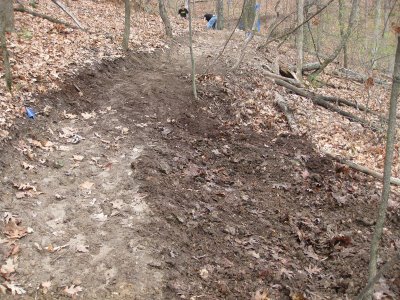After a GORC peer review with other trail stewards is complete and a final line is selected, we will get the land manager’s approval. Once the design is signed off we prepare for the trail building event by laying out pin flags on the forest floor. Pin flags are placed on the high side of the trail. They are spaced 5 – 15 feet apart so volunteers can see where the trail bed should go. Tight, intricate and complex trail segments may feature pin flags only a foot apart to show exactly where the singletrack must go. Prior to the build day, a leaf blower is used to prepare the trail surface and show a rough outline of the tread alignment. Otherwise at the trail building event, our volunteers rake the leaves to the low side of the trail so the dirt is exposed and the work begins. The trail bed is cut in to the hill slope with the final tread angled 3% – 5% off-camber to facilitate water drainage and prevent pooling. The tread backslope is beveled at a 45 degree or less angle to keep water flow from eroding the backside of the slope. You can see in the picture how the high side slope is feathered in.
The dirt that is removed in the making of the bench cut is scraped off the trail on the downhill side or sideslope. The dirt must be pulled far enough away so that trail users do not think the “fluff” dirt is part of the solid tread. If the fluff is used as a trail bed it will quickly rut and erode. It is very important that only the bench cut is used as the tread. This is also why we must make the bench cut wide enough for multi-use traffic, especially at places that have high equestrian use such as Greensfelder.
Lastly, you can see the new trail is not just a straight cut through the trees. It is designed with flow in mind – this keeps all trail users engaged with the trail and entertained. The trail appears more natural this way. Grade reversals are utilized to shed water off the tread. This is what makes a trail feel flowy.
The singletrack is designed around the mature live trees. Only saplings and deadfall are cut – and then only sparingly. Large, old growth trees are used as trail anchors and keep the singletrack line from drifting or migrating when equestrians or bikers may want to use an easier path. If you ever visit a trail system that has few trees you can see how the trails can be very wide due to trail drift. A trail system like SIUE or Cliff Cave prevents singletrack from growing wide due to the thick undergrowth. Next time you ride, check it out.
TRAIL BUILDING OBSTACLES AND LINE SELECTION
Flush cut stumps or large dead ones must be removed with lots of hard work. You may think singletrack can just go through the forest willy-nilly but when you factor in fall-line issues, slope grade percentages, line of sight and the flow of a given turn radius you can understand why a simple stump can get in the way of our trail bed.
Sometimes a stump or a small sapling is in the middle of a critical spot on the trail. Singletrack occasionally needs to go exactly where a small sapling is established. Attempting to move the trail below (or above) it may create undesirable features such as a sharp non-flowy turns, too-steep climbing grade and a poor line-of-sight.


